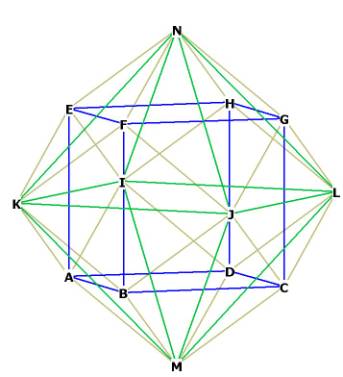|
(2017
midterm assignment) Model Student Midterm answers 2017 (Index) Essay 2: Personal / professional topic |
 |
Neil LeBoy
Come Together or Fall Apart
What do you imagine when envisioning a future society?
Do you picture hover cars and teleporters transporting people through a
city in the sky, or do you imagine the future as apocalyptic and digressive?
More importantly, which future is more realistic? Dr. White suggested I research
the debate between “cornucopians and doomers” to better understand how people
view the future. In short, cornucopians believe the world will develop
technology to properly address the problems of growing populations with limited
natural resources, “The term cornucopia has its roots in Greek mythology. It
translates to the “horn of plenty”, which magically supplied its owner with
endless food and drink” (web). Opposing this view, “malthusians or doomers”
believe the worlds cannot produce enough resources to adhere to the rapidly
growing population. (Web) Using course readings and outside sources for research
I will debate and decide if I should agree with the cornucopians or the doomers.
Personally, I find the most valid arguments to be based in actuality. I
also am a proponent of, “see it to believe it”, which makes me skeptical of all
future visions. Is a cornucopian view more or less realistic than a doomers view
or vice versa? When dealing with realism in Literature the Oxford Dictionary
defines realism as “the attitude or practice of accepting a situation as it is”
(course web). The realism in Parable of
the Sower and “Stone Lives” made the future visions presented easier to
follow and accept as a possibility. Neither future sounded pleasant to live in
though; one point for the doomers.
Technology will save us all through gastronomy. In the article
“Cornucopia: The Concept of Digital Gastronomy”, the idea of technology is
linked to something I love, food. The article presents the idea of an affordable
3D printer that will print people food (Zoran 245-51). Authors in the past
including Isaac Asimov’s
Foundation presented future visions
of turning common material into gold, “and although creating gold is still a
distant dream, our ability to manipulate matter and shapes is increasing” (Zoran
425). Besides, who really wants to end up like King Midas? The article mentions
companies including “Phillip’s Design” (426) that are currently looking into
future gastronomy. The authors of the article even create their own version of a
3D printer that can produce basic foods to show how realistic future gastronomy
is. They explain by illustrating the machine, “They can be understood as a
realistic vision and, as such, the vision encourages discussion and public
interest” (431). This quote really got me thinking, it would be impossible to
change the future for the better if no one attempts to. Now I find not only are
people attempting to change the future, but could possibly be close to doing it.
Instead of scavenging the Bungle for scraps of food, Stone could have access to
a machine that prevents hunger. Imagine the effect the 3D printer would have for
Lauren’s group, “Earthseed”, she would have the ability to feed her entire group
with the push of a button. What if someone created a machine that turned large
quantities of ocean water into fresh water? Before diving too far into what ifs,
and alternative futures, I will admit the cornucopians in this article have
inspired me.
I would love to imagine the world
will take care of itself. People would replenish what they take from the world,
and try not to hurt each other. I want a 3D printer to cook me steaks every
night before bed. For now, these ideas are completely unrealistic. Could the
doomers be right, is civilization spiraling towards an apocalypse? It is
completely possible, even tomorrow the possibility of bombs wiping out humanity
is present. Larry D. Wilcox presents the ideas of well-known doomers in part of
his article, “Futurology and the Social Sciences Bloom and Boom or Gloom and
Doom?” Wilcox quotes the words of a prominent doomer Robert Heilbronner to
express his overall position, “Nothing short of a total solution to the problems
of population growth, nuclear danger, or economic growth would vitiate the
larger anticipation of a rendezvous with forces that will subject human society
to the buffet of a mighty storm” (Wilcox 208). Wilcox compares these ideas to
those of scripture, and argues “this type of projecting should be left to
pundits, prophets, professors, physicians and politicians” (Wilcox 208). Wilcox
also thinks future studies in courses like our own should concentrate on
alternative and “preferred” (209) futures. I agree with Larry Wilcox, why think
about the worst case scenario if we can be preparing for the best. Just as
impossible is to argue against the doomers. How long can people continue to
exist without society falling apart? One big war, or simply ignoring
overpopulation could have disastrous consequences. Perhaps, novels like
Parable and stories including “Stone
Lives” serve as a guide for doomers in case things do go wrong in the future.
I would have to choose to be a cornucopian over a doomer. At the same
time, I want to be prepared to evolve and adapt in case the doomers end up
correct. Studying Literature of the future could be key in the actual shape of
the future. I mentioned when beginning the class I was confused by the class’s
purpose, but see now there is great importance in the future narratives. Just as
today shapes the future, ideas of the future help shape today. Instead of
looking at Parable and “Stone Lives”
as realistic visions of the future, I could think in terms of realistic ways of
preventing those futures including 3D printers and my fresh water idea. Larry D.
Wilcox directly mentioned the future literature course at U.H.C.L. on page 205
as a progressive step towards studying the future through Literature. His quote
at the end of the article struck me deeply, “The future remains in the past and
present of human beings.” (209). People have the ability to change the future.
We can make it better.
Butler,
E. Octavia. Parable of the Sower.
First Grand Central Publishing. 2000. New York, NY.
Flippio,
Di Paul. “Stone Lives”. Class Handout.
Wilcox,
Larry D. “Futurology and the Social Sciences Bloom and Boom or Gloom and Doom?”
International Social Science Review, vol. 58, no. 4, 1983, pp. 202–210.
JSTOR, JSTOR, www.jstor.org/stable/41881475.
Web.
“Cornucopia” <https://www.intelligenteconomist.com/cornucopia/>
Accessed November 5th 2017.
White,
Craig. LITR 4368 Literature of the Future.
Course Website.
<
http://coursesite.uhcl.edu/HSH/Whitec/LITR/4632/default.html>
Zoran,
Amit, and Marcelo Coelho. “Cornucopia: The Concept of Digital Gastronomy.”
Leonardo, vol. 44, no. 5, 2011, pp. 425–391. JSTOR, JSTOR,
www.jstor.org/stable/41421765.
 |
 |
 |
